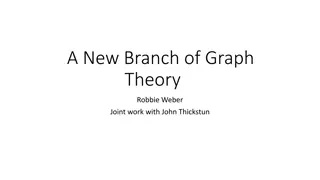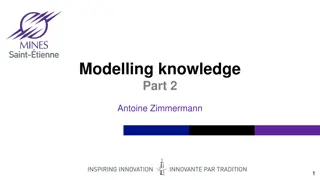Association Rules with Graph Patterns: Exploring Relationships in Data
Dive into the world of association rules with graph patterns, where relationships and connections are analyzed through nodes and edges. Discover how to define association rules, identify customers, and uncover interesting patterns using graph-based techniques. Explore traditional and graph-pattern association rules, and learn how they can be applied to various scenarios, from social networks to customer identification.
Download Presentation

Please find below an Image/Link to download the presentation.
The content on the website is provided AS IS for your information and personal use only. It may not be sold, licensed, or shared on other websites without obtaining consent from the author.If you encounter any issues during the download, it is possible that the publisher has removed the file from their server.
You are allowed to download the files provided on this website for personal or commercial use, subject to the condition that they are used lawfully. All files are the property of their respective owners.
The content on the website is provided AS IS for your information and personal use only. It may not be sold, licensed, or shared on other websites without obtaining consent from the author.
E N D
Presentation Transcript
Association Rules with Graph Patterns Association Rules with Graph Patterns Wenfei Fan Jingbo Xu Xin Wang Yinghui Wu Yinghui Wu Washington State University Southwest Jiaotong University University of Edinburgh
Association in social networks Traditional association rules: X Y Association in social networks French restaurant if customers x and x are friends living in the same city c, there are at least 3 French restaurants in c that x and x both like, and if x visits a newly opened French restaurant y in c, then x may also visit y. y visit x x French3 restaurant city Association with topological constraints! Identify customers for a new French restaurant Conventional association rules: item set 2
Association via graph patterns x2 fake acc #2 acc #1 x1 x blog blog Ecuador article Shakira album claim a prize (keywords) Identify customers for released album detect fake account Question 1: How to define association rule via graph patterns? Question 2: How to discovery interesting rules? Question 3: How to use the rules to identify customers? more involved than rules for itemsets! 3
Graph Pattern Association Rules (GPARs) graph-pattern association rule (GPAR) R(x, y) R(x, y): Q(x, y) q(x, y) Q(x, y): a graph pattern; where x and y are two designated nodes q(x, y) is an edge labeled q from x to y (predicate) Q and q as the antecedent and consequent of R, respectively. French restauran t French restauran t French restauran t : x x x x x French3 restaurant French3 restaurant city city Q(x, French restaurant) like(x, French restaurant) R(x, French restaurant): 4
Graph Pattern Association Rules (GPARs) graph-pattern association rule (GPAR) R(x, y) R(x, y): Q(x, y) q(x, y) If there exists a match h that identifies vxand vyas matches of the designated nodes x and y in Q, respectively, then the consequent q(vx, vy) will likely hold. if x and x are friends living in city c, there are at least 3 French restaurants in c that x and x both like, and if x visits a newly opened French restaurant y in c, then x may also visit y. French restauran t French restauran t French restauran t : x x x x x French3 restaurant French3 restaurant city city Q(x, French restaurant) like(x, French restaurant) R(x, French restaurant): 5
Support and Confidence Support of R(x, y): Q(x,y) p(x,y) ????(?,?) = |?(?,?)| # of isomorphic subgraph in single graph? anti-monotonicity: ???? ?1,? ???? ?2,? ?? ?2 ?? ? ?????????? ?? ?1 Le Per se Bernadin French restauran t u2 u3 u1 x x New York (city) French3 restaurant city French3 restaurant French3 restaurant 6
Support and Confidence Candidate # of x with one edge of type q but is not a match for q(x,y) Confidence of R(x, y) ???? ?,? ????( ?,?) ???? ? ?,? ????(?,?) ????(?,?) = Local closed world assumption v2 x2 v1 v v' x1 v'' x hobby MJ s album Shakira album Ecuador Pop music unknown Ecuador Shakira album negative positive 7
Discover GPARs Mining GPARs for particular event often leads to same group of entities French restaurant y Diversified GPARs French restaurant y Difference function ????(?1,?2) =??1(?,?) ??2(?,?) ??1(?,?) ??2(?,?) Bi-criteria Diversification function city restaurant x x x X Asian restaurant French2 city ????(??) ? 2 ? ? = 1 Le Bernadin + ? 1 ??,?? ?,?<?????(??,??) restaurant Per se Patina Asian ?? The diversified mining problem: u1 u2 u3 u4 u5 u6 Given a graph G, a predicate q(x, y), a support bound and positive integers k and d, find a set S of k nontrivial GPARs pertaining to q(x, y) such that (a) F(S) is maximized; and (b) for each GPAR R S, supp(R,G) and r(PR, x) d. restaurant restaurant New York (city) LA (city) Asian restaurant French3 French3 French3 restaurant 8
Parallel GPAR Discovery A parallel GPAR discovery algorithm DMine coordinator Scdivides G into n-1 fragments, each assigned to a processor Si discovers GPARs in parallel by bulk synchronous processing in d rounds Sc posts a set M of GPARs to each processor each processor generates GPARs locally by extending those in M new GPARs are collected and assembled by Scin the barrier synchronization phase; Sc incrementally updates top-k GPARs set Lk Assembled New GPARs Mi+1 Lk R2 R1 Rk coordinator 3. Synchronization/ Update Lk 1. Distribute Mi worker 1 worker 2 worker n 2. Locally expand Mi 9
Identifying entities using GPARs Given a set of GPARs pertaining to the same q(x,y), graph G and confidence threshold , the set of entities identified by is the set ?,?, = {?|? ? ?,? ,?(?,?) ?(?,?) ,????(?,?) } The entity identification problem (EIP): given , G, q(x,y) and , compute the entity set ?,?, . NP-hard even when contains a single GPAR 10
Entity Identification algorithm Parallel scalability An algorithm is parallel scalable if ?( ? ,|?|) ? ?1 ? ? , ? ,? = ? + ? ? ? ? , ? ,? : worst case running time for solving problem A over graph G using n processors ?( ? ,|?|): worst case running time of sequential algorithm A parallel scalable GPAR matching algorithm Matchc Partition (d-hop preserving partition for candidates of x) Local Matching: compute local matches Q(x, Fi) at each fragment Fi in parallel Assumbling: compute conf(R,G) for each R in . Return matches of R(x, G) with conf(R,G) at least Optimized version Match using guided search 11
Experimental study We used real-world social networks Pokec: 1.63 million nodes of 269 different types, and 30.6 million edges of 11 types (follow, like) Google+: 4 million entities of 5 types and 53.5 million links of 5 types. Algorithms: DMine vs DMine without optimization and GRAMI* Matchc vs disVF2, Match and MatchS * M. Elseidy, E. Abdelhamid, S. Skiadopoulos, and P. Kalnis.GRAMI: frequent subgraph and pattern mining in a single large graph. PVLDB, 7(7):517 528, 2014. 12
Scalability of discovery algorithm On average 3.2 time faster 13
Scalability of Entity identification On average 3.53 time faster Find matches for 24 GPARs over G of size 150M in 45s, using 20 processors 14
Conclusion and future work Association rules in social and information networks are more involved We propose association rules with graph patterns (GPARs) from syntax, semantics to support and confidence. We studied DMP and EIP problem, for GPARs discovery and identifying potential customers with GPARs. We show that it is feasible to discover and make practical use of GPARs over large networks Future work Extend GPARs by supporting graph patterns as consequent Allow more types of graph pattern matching semantics 15
Association Rules with Graph Patterns Thank you! Thank you! 16
GPARs discovery examples Disco if x follows user1, user1 follows user2, user2 follows x, user1 and user2 share the hobby to listen to music, x and user1 share the hobby of party, and if user2 likes Disco music, then x likes Disco. usr usr2 usr1 listen to music party usr2 usr if x and x follow each other and both like books of profession development, and if x likes books about personal development, then so does x. personal development Professional development Computer science if x follows x , both x and x went to CMU, both x and x are employees of Microsoft, and if x was majored in CS, then x was also likely majored in CS. x x CMU 17
GPARs with Different confidence measures ???? ?,? ???? ??,? ???????(?,?) = ?????(?,?) =????? ?,? ?????( ?,?) ????? ?,? ?????(?,?) 18























